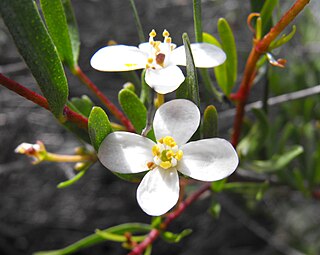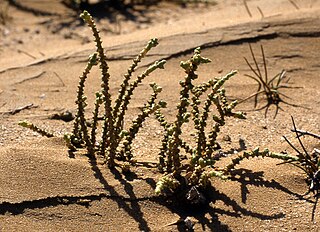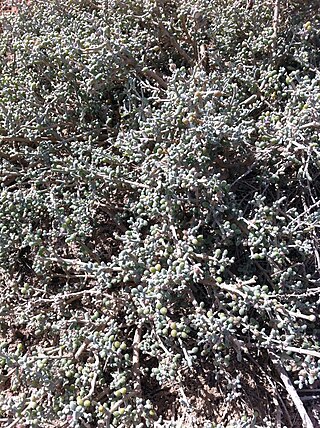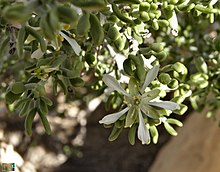
The geography of Israel is very diverse, with desert conditions in the south, and snow-capped mountains in the north. Israel is located at the eastern end of the Mediterranean Sea in West Asia. It is bounded to the north by Lebanon, the northeast by Syria, the east by Jordan and the West Bank, and to the southwest by Egypt. To the west of Israel is the Mediterranean Sea, which makes up the majority of Israel's 273 km (170 mi) coastline, and the Gaza Strip. Israel has a small coastline on the Red Sea in the south.

The Negev or Negeb is a desert and semidesert region of southern Israel. The region's largest city and administrative capital is Beersheba, in the north. At its southern end is the Gulf of Aqaba and the resort city and port of Eilat. It contains several development towns, including Dimona, Arad, and Mitzpe Ramon, as well as a number of small Bedouin towns, including Rahat, Tel Sheva, and Lakiya. There are also several kibbutzim, including Revivim and Sde Boker; the latter became the home of Israel's first Prime Minister, David Ben-Gurion, after his retirement from politics.

Zygophyllaceae is a family of flowering plants that contains the bean-caper and caltrop. The family includes around 285 species in 22 genera.

Fagonia is a genus of wild, flowering plants in the caltrop family, Zygophyllaceae, having about 34 species. The latest reorganization of the genus took place in 2021 when systematists Christenhusz & Byng included Fagonia spp.. along with several other Zygophyllum genera, into a new genus named "Zygophyllum L." Species occurring in the US are commonly referred to as fagonbushes. The distribution of the genus includes parts of Africa, the Mediterranean Basin, the Mid-East, India, and parts of the Americas. Fagonia species have been used ethnobotanically by traditional practitioners under Ayurvedic and other TM healing regimes for many maladies. Species occur in deserts, dry washes, ditches and on rocky outcrops, including at altitude.

Yatir Forest is a forest in Israel on the edge of the Negev Desert. The forest covers an area of 30,000 dunams, and is the largest planted forest in Israel.

Ashalim is a small community settlement in southern Israel. Located in the Negev desert about 35 km south of Be'er Sheva and on the eastern side of Nahal Besor, the largest stream in the Negev, it falls under the jurisdiction of the Ramat HaNegev Regional Council. In 2021 its population was 681. Nearby settlements include Ezuz and Nitzana.
Tetraena giessii, synonym Zygophyllum giessii, is a species of plant in the family Zygophyllaceae. It is endemic to Namibia. Its natural habitats are rocky areas and cold desert. It is threatened by habitat loss.

Zygophyllum is the type genus of the flowering plant family Zygophyllaceae. The generic name is derived from the Greek words ζυγόν (zygon), meaning "double", and φυλλον (phyllon), meaning "leaf". It refers to the leaves, each of which have two leaflets.

Cneoridium is a monotypic genus in the citrus family which contains the single species Cneoridium dumosum, commonly known as bushrue or coast spice bush. As a perennial, evergreen shrub, Cneoridium is native to the coast of southern California and Baja California, thriving in hot, dry conditions. This plant is characterized by a distinctive citrusy aroma and small, white flowers that appear from winter to spring. The flowers eventually become round berries that resemble a miniature version of the common citrus.
Negevite pottery, Negev pottery, Negebite ware, etc. are the names given to a hand-made ware, i.e. without using the potter's wheel, found in Iron Age sites of the Negev desert, southern Jordan, and the Shfela of Israel. However, its use was not limited to the Iron Age, starting instead in the Bronze Age and continuing uninterruptedly until the Early Muslim period.

Nitraria retusa, commonly known as Nitre bush, is a salt-tolerant and drought-resistant shrub in the family Nitrariaceae. It can grow to heights of 2.5 metres, although it seldom exceeds more than 1 m in height. It produces small white/green coloured flowers and small edible red fruit. The plant is native to desert areas of northern Africa, where it grows in primary succession on barren sand dunes, and in areas with high salinities such as salt marshes.

Roepera similis is a succulent annual herb native to Australia.
Morocco provides a refuge for a rich and diverse flora with about 4,200 taxa, of which 22% are endemic. The phytogeographic zones of Morocco comprise 8 zones: the Mediterranean zone, the Cedar zone (1000-2000m), the sub-Alpine zone (2,000-2,500m), the Alpine zone (2,500m+), the semi-desert scrub zone, the Reg, the sandy desert zone and the oases.

Cornulaca monacantha is a species of flowering plant in the genus Cornulaca, that is now included in the family Amaranthaceae,. It is a desert plant found in the Middle East and the Sahara, and the southern end of its range is considered to delineate the edge of the desert. In Arabic it is known as had and djouri, and the Tuareg people call it tahara. It was first described in 1813 by the French botanist Alire Raffeneau Delile.
Tetraena qatarensis is a salt-tolerant dwarf shrub that grows in the Arabian Peninsula. It has small compact leaves that store water. The leaflets grow in pairs and the flowers have four or five petals.

Tetraena alba is a species of plant in the family Zygophyllaceae which is found in arid regions of Africa and the Arabian Peninsula. It is a salt tolerant plant and dominates many of the plant communities in which it grows.

Iris atrofusca is a species in the genus Iris, where it is placed in the subgenus Iris and the section Oncocyclus. It is a rhizomatous perennial from the deserts of Israel and Jordan. The species has long falcate (sickle-shaped) or ensiform (sword-shaped) leaves, a long thick stem and large fragrant flowers that come in shades of purple brown, reddish-black, black-brown, dark brown, dark lilac or dark purple. The flowers also have a black or brownish-black signal patch and a thick beard that is brown-black, light brown or yellow tipped with brown. It is rarely cultivated as an ornamental plant in temperate regions.

Tetraena is a genus of flowering plants in the family Zygophyllaceae.

Tetraena simplex, commonly known as hureim or simple-leaved bean caper, is a halophytic flowering plant that is distributed in arid regions of the Western Asia and Africa. It is an annual and has a history of being used in Arabic folk medicine as an anti-inflammatory.
Zygophyllum pterocaule is a species of flowering plant in the family Zygophyllaceae, native to Namibia, and the northern Cape Provinces of South Africa. A succulent, decumbent shrub, it only reaches 15 cm (6 in) high, but spreads to 80 cm (30 in).
















